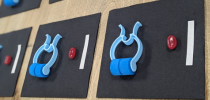How can using different senses change the way we cook and eat?

We all know that our senses have a big impact on how and what we eat, but what happens when we take away one of our senses or trick them by changing the way in which the food is presented?
Eating engages our senses: sight, smell, hearing, taste, and touch. These senses work together to help us assess and enjoy the food we consume. However, if a sense is not engaged, we focus on the others to determine our liking towards a particular experience. If sight is removed, we may depend on the aroma, flavour, texture, and even the sound the food makes on the plate or in our mouth. So, even if a dish may not look tempting, the other senses may reassure us otherwise.
Back in July 2023, Churchill and Continental Chef Supplies invited National Chef of the Year Semi-finalists to our London Innovation Centre for an immersive dining experience with innovative sensory stations focusing on the impact of sound, shape and aroma.
The day began with a captivating session led by Professor Charles Spence, an expert in Experimental Psychology from Oxford University where he talked of the power of colour: "Back in 2003, Heston Blumenthal was working on a pink ice cream...when he served it, customers said it was horrible and salty. However, Heston knew it was a savoury ice cream whereas the customers did not; so they assumed it was a sweet flavour based on the pink colour. This created an instant dislike for the unusual taste. This is how colour can set the expectation of our tastes".
Watch the Video and Press Release from this event here.
Sight
Our sense of sight can also be subverted by how the food is presented. If the food is brown, mushy and lumpy, consumers could be put off. But, if the food is colourful, neat and tidy, consumers could be more willing to eat it. As well as the food, the choice of tableware can enhance the flavour of food. Professor Charles Spence explained: "For a blue and white plate, our brains associate it with the sea and saltiness and would be used for fish dishes. A pink, rounded dish would be associated with sweetness and desserts."
Smell
According to Scienceworld.ca, our sense of smell is responsible for around 80% of what we taste. Without it, our sense of taste is limited to sweet, salty, sour, bitter and savoury sensations. If you hold your nose and eat a jelly bean for example, you would detect its sweetness, not its flavour. If you then release your nose, you will be able to taste the full flavour of the bean such as strawberry or orange. Our sense of smell can also trigger memories and nostalgia which would make us more attracted to the foods we are eating. According to Healthnews.com, smell can take us back to the past. Whether thats a loving, safe or more negative memory, smell can unlock it. Meaning that when we smell something familiar, we associate it with those emotion-evoking memories. This simple idea could encourage restaurants to dish up traditional or regional dishes that are more likely to transport customers back in time to a positive memory.
Sound
A study from University of London conducted a survey across 250 adults from the UK and found that respondents ranked sight as their most valuable sense and hearing as their second most valuable sense. When listening to a burger that is sizzling away on a grill, it sends happy signals to your brain and can create an emotional response based on how we feel towards certain foods. Our sense of hearing can also change our perception of food, whether this is the soundtrack playing in the restaurant, or the conversations we can hear nearby.
Pictured: During our Kitchen Theory event at the London Innovation Centre, we presented the Chefs with headphones playing a selection of crunchy, cracking oceanic noises (picture ice drifts breaking apart), whilst they enjoyed a sustainable Seaweed and Jellyfish Salad. The dish was notoriously soft and non-descript, but the addition of cracking sounds playing through headphones journeyed down the jawline and gave our Chefs the perception of a crunchy texture, totally altering the dining experience.
Touch
Similarly, when it comes to our sense of touch, certain sensations can impact the feeling we have towards a certain dish. Touching different objects with our hands can trigger enhanced sensory responses which can make the food in front of us more or less desirable. For instance, according to six studies conducted at Harvard and Yale Universities; “touching a soft or hard object can influence how a person thinks or even makes decisions, researchers now say…and could affect how people haggle over the price of a new car or negotiate high-stakes diplomacy.” This type of research could have real-world implications into a restaurant’s tableware and cutlery presentation choices, and how they complement the food they are designed to present.
Many restaurants and chefs across the world have been using the 5 senses to their advantage and providing guests with a sit-down meal that they will never forget. Some include using vrtual reality headsets, lighting, sounds, different smells in the room and theatricality. Read the full article here.
We all know that our senses have a big impact on how and what we eat, but what happens when we take away one of our senses or trick them by changing the way in which the food is presented?
Eating engages our senses: sight, smell, hearing, taste, and touch. These senses work together to help us assess and enjoy the food we consume. However, if a sense is not engaged, we focus on the others to determine our liking towards a particular experience. If sight is removed, we may depend on the aroma, flavour, texture, and even the sound the food makes on the plate or in our mouth. So, even if a dish may not look tempting, the other senses may reassure us otherwise.
Back in July 2023, Churchill and Continental Chef Supplies invited National Chef of the Year Semi-finalists to our London Innovation Centre for an immersive dining experience with innovative sensory stations focusing on the impact of sound, shape and aroma.
The day began with a captivating session led by Professor Charles Spence, an expert in Experimental Psychology from Oxford University where he talked of the power of colour: "Back in 2003, Heston Blumenthal was working on a pink ice cream...when he served it, customers said it was horrible and salty. However, Heston knew it was a savoury ice cream whereas the customers did not; so they assumed it was a sweet flavour based on the pink colour. This created an instant dislike for the unusual taste. This is how colour can set the expectation of our tastes".
Watch the Video and Press Release from this event here.
Sight
Our sense of sight can also be subverted by how the food is presented. If the food is brown, mushy and lumpy, consumers could be put off. But, if the food is colourful, neat and tidy, consumers could be more willing to eat it. As well as the food, the choice of tableware can enhance the flavour of food. Professor Charles Spence explained: "For a blue and white plate, our brains associate it with the sea and saltiness and would be used for fish dishes. A pink, rounded dish would be associated with sweetness and desserts."
Smell
According to Scienceworld.ca, our sense of smell is responsible for around 80% of what we taste. Without it, our sense of taste is limited to sweet, salty, sour, bitter and savoury sensations. If you hold your nose and eat a jelly bean for example, you would detect its sweetness, not its flavour. If you then release your nose, you will be able to taste the full flavour of the bean such as strawberry or orange. Our sense of smell can also trigger memories and nostalgia which would make us more attracted to the foods we are eating. According to Healthnews.com, smell can take us back to the past. Whether thats a loving, safe or more negative memory, smell can unlock it. Meaning that when we smell something familiar, we associate it with those emotion-evoking memories. This simple idea could encourage restaurants to dish up traditional or regional dishes that are more likely to transport customers back in time to a positive memory.
Sound
A study from University of London conducted a survey across 250 adults from the UK and found that respondents ranked sight as their most valuable sense and hearing as their second most valuable sense. When listening to a burger that is sizzling away on a grill, it sends happy signals to your brain and can create an emotional response based on how we feel towards certain foods. Our sense of hearing can also change our perception of food, whether this is the soundtrack playing in the restaurant, or the conversations we can hear nearby.
Pictured: During our Kitchen Theory event at the London Innovation Centre, we presented the Chefs with headphones playing a selection of crunchy, cracking oceanic noises (picture ice drifts breaking apart), whilst they enjoyed a sustainable Seaweed and Jellyfish Salad. The dish was notoriously soft and non-descript, but the addition of cracking sounds playing through headphones journeyed down the jawline and gave our Chefs the perception of a crunchy texture, totally altering the dining experience.
Touch
Similarly, when it comes to our sense of touch, certain sensations can impact the feeling we have towards a certain dish. Touching different objects with our hands can trigger enhanced sensory responses which can make the food in front of us more or less desirable. For instance, according to six studies conducted at Harvard and Yale Universities; “touching a soft or hard object can influence how a person thinks or even makes decisions, researchers now say…and could affect how people haggle over the price of a new car or negotiate high-stakes diplomacy.” This type of research could have real-world implications into a restaurant’s tableware and cutlery presentation choices, and how they complement the food they are designed to present.
Many restaurants and chefs across the world have been using the 5 senses to their advantage and providing guests with a sit-down meal that they will never forget. Some include using vrtual reality headsets, lighting, sounds, different smells in the room and theatricality. Read the full article here.




Leave a comment